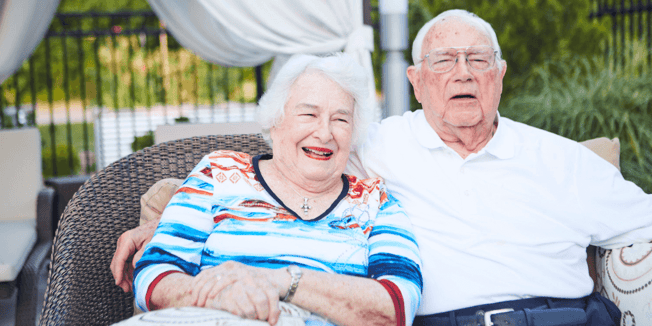Retirement, Redefined: From Nursing Homes to Senior Living Communities

Most older adults say they want to stay in their house as long as possible. It’s where they’ve lived for many years, and they have many fond memories in the family home. Fear of the unknown, perceived loss of independence, and misconceptions about senior living communities also can contribute to the desire to stay.
However, today’s senior living communities are nothing like the communities of the past. When this generation of seniors was young, nursing homes were cold, institutional-style places. That’s the picture that may be in your parent’s or loved one’s mind when they think of senior living communities.
Today, senior living communities are vibrant and empower residents to live their lives to the fullest. In addition to offering lots of activities and events, there are plenty of opportunities to make new friends and nurture existing relationships with loved ones.
A senior living community can empower residents to build a life that they choose, no matter what they want from their future. At Cedarhurst, we fully embrace this idea by meeting our residents where they are and empowering our residents to live their truth. Our Living TRUESM commitment ensures a retirement tailored to each resident’s needs, goals, and passions.
Senior Living Communities vs. Nursing Homes: What’s the Difference?
There are some key differences between a nursing home and a senior living community, including everything from the type of care provided to the living space.
Nursing Homes
“Nursing home” has become a blanket term for any type of senior living community; however, it’s inaccurate. A “nursing home” is actually a skilled nursing community. This type of community offers high-level, 24/7 nursing care for residents there for a short-term stay of a few months or a long-term stay of a few years or longer due to sudden health decline or recovery from hospitalization.
Skilled nursing communities offer wound care, intravenous injections, catheter care, or pain management services, depending on the individual’s unique needs. This type of community also offers on-site speech, physical, and occupational therapy. These services are administered under the direct supervision of registered nurses (RNs) and occupational, speech, or physical therapists.
In a skilled nursing community, the ratio of staff to residents is much higher because of the level of care that residents need. Due to the type of care provided in these communities, they may look a bit more like a hospital. It’s important to note that although many assisted living communities also offer similar services such as on-site physical therapy, in a skilled nursing community, the therapy provided is generally more intense and there are often more sessions during the days and weeks.
Senior Living Communities
Skilled nursing communities provide a clinical setting, but senior living communities offer a more home-like, social environment where each resident has their own private, updated apartment.
Depending on the senior living community, it may offer amenities such as special events, shopping trips, bistros, libraries, and more. These communities encourage residents to live their lives to the fullest while providing the right amount of caregiver assistance, depending on what each resident needs. Senior living communities feel more like home and have a warmer, less clinical feel compared to a skilled nursing community.
There are three different types of senior living communities to choose from, depending on your loved one’s unique care needs. All levels of care offered in a senior living community are less acute than skilled nursing.
Independent living is ideal for seniors who are still self-reliant but want to downsize from the family house. Individuals who live in an independent living community want to focus on what they enjoy rather than the stresses of homeownership. These communities can offer a wide range of activities and amenities such as arts and crafts, entertainment, and more. Little to no care or daily assistance is offered in independent living.
Assisted living empowers residents to maintain their independence while also providing for specific care needs, such as assistance with dressing, eating, or bathing. Those who live in an assisted living community don’t require intensive nursing or medical care, but they may receive assistance with medication management, or healthcare management and monitoring.
Memory care is a specialized community that offers care for residents with Alzheimer’s disease or other types of dementia. These communities take care of the resident’s physical, medical, and memory care needs while providing specialized resources for memory loss treatment. The programs offered in this type of community depend on which stage of the dementia process a resident is in, and each resident has a service plan tailored to their unique needs.
A Focus on Joy and Growth
At Cedarhurst Senior Living, we believe in embracing age and empowering our residents to build the life they choose, no matter what they want from their future, who they are, or whether they live in independent living, assisted living or memory care.
Our mission is for our residents to live their truth as they understand it. Therefore, we’ve incorporated our Living TRUESM commitment into our values:
- Tailored to You: Our communities aren’t one-size-fits-all. We listen to each resident and help them shape the life they desire.
- Relationships of Integrity and Trust: Relationships are part of what makes life worth living, so we’ve built communities that our residents are proud to invite their loved ones into.
- Uplifted to Live Your Best Life: We focus on the right amount of fitness, wellness, and gentle support—the amount each resident needs and only when they want it—to ensure each resident is living life on their own terms.
- Excitement of the Senses: We make sure our residents are enjoying beautiful views, opportunities for joy and entertainment, and exceptional dining experiences.
We work with each resident to understand what suits their needs and who they are in order to tailor their experiences, whether that’s the amount of assistance they need or the amount of physical fitness they would like. We want to understand who our residents are as individuals so we can take the right steps to support them.
Why a Senior Living Community Could Be Ideal for Your Parent or Loved One
Senior living communities promote independence by prioritizing good health and staying active. They offer varying levels of personalized support, ensuring your parent or loved one can live life to their fullest while receiving the amount of care they need.
Family is important, and maintaining the family relationship is one of the things that’s top of mind for most people. To nurture existing connections with family members, senior living communities provide plenty of community spaces for events in addition to the comfortable, welcoming apartment that’s an ideal location to visit with friends and family.
Think of the senior living community like a town within itself—there are special events, friendly neighbors, and regular routines. Depending on the specific location, senior living communities may also offer unique amenities and activities such as off-site excursions, volunteer opportunities, and even shopping opportunities. Your parent or loved one will have many opportunities to meet new people and make new friends with common interests through these excursions.
Is a Senior Living Community Right for Your Parent or Loved One?
Determining if it’s the right time for senior living for your parent or loved one can be overwhelming. You may be feeling a lot of complex emotions, and it’s important to acknowledge them.
WONDERING WHETHER IT’S TIME FOR YOUR LOVED ONE TO CONSIDER THE MOVE TO A SENIOR LIVING COMMUNITY? They may find the support and lifestyle they need in senior living if they are currently:
- Exhibiting signs of memory loss or dementia
- Experiencing an increased number of falls or other physical risks
- Exhibiting signs of loneliness or isolation
- Experiencing difficulty maintaining the family house
Senior living communities can support your parent or loved one at the level they need, and your parent or loved one can socialize as much as they like while maintaining their current lifestyle. Your parent or loved one can also keep many of their possessions while receiving specialized care. And at a senior living community, the housekeeping and landscaping tasks are even removed from your parent’s or loved one’s to-do list.
Not sure which lifestyle option is right for you? Learn about your options and get personalized results in about 4 minutes.
Take the AssessmentA Welcoming Community for Your Parent or Loved One to Live to Their Fullest
Cedarhurst welcomes residents from all walks of life, embracing a lively and enjoyable retirement for all. We encourage our residents to live, serve, eat, and more—exactly how they like to.
Wondering if it’s the right time for senior living for your parent or loved one? Take our free, quick assessment today. After you take the assessment, download our comprehensive guide, What Makes Cedarhurst Different from Other Senior Living Communities?, to learn more about the Cedarhurst difference.





.png?width=307&height=200&name=Blog%20%2333%201400%20x%20700%20(1).png)

.png?width=307&height=200&name=Blog%20%2332%201400%20x%20700%20(8).png)



